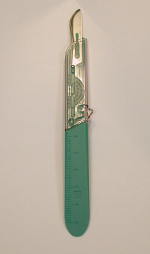Treating Cancer: Local Therapy
Author: John Published Under: Health

There are many different types of cancer, which affect different parts of the body. As a result, the way that these types of cancer are treated can greatly vary. There are, however, two basic types of cancer treatment, namely local and systemic therapy. During systemic therapy, the entire body is treated, while during local therapy, only the affected part of the body is treated.
Surgery
One common type of local cancer therapy is surgery. During surgery, the doctor will remove the tumor, as well as a portion of the tissue surrounding the tumor. By removing the tissue surrounding the tumor, it is hoped to prevent it from returning or spreading. It is also common for the doctor to remove nearby lymph nodes.
Any type of surgery can and is dangerous and usually has side effects, but, in the case of cancer, this can vary depending on what type of cancer is present and where the tumor is located. It will also take time for the body to recover from the surgery, which varies depending on the individual.
There is also usually some discomfort, although pain medication can and is usually prescribed. It is important to discuss what will be used for pain relief prior to surgery, as well as the risks of developing chemical addictions.
There are some that believe having a surgery, or for that matter even a biopsy, causes the cancer to spread. However, this is not usually the case, as doctors take measures to prevent this from happening. One common method is to use new clean tools each time the body is entered.
Others worry that exposing the cancer to air will cause the surgery to spread, although this is not the case and air does not cause cancer to spread.
Radiation Therapy
Another type of localized cancer treatment is radiation therapy, where very powerful radiation energy rays are used to kill the cancer cells. This will usually kill the cells, causing the tumor to go away or at least shrink. There are three basic types of radiation that is used to treat cancer locally, specifically external radiation, internal radiation, and systemic radiation, with the last, systemic radiation not being a local cancer therapy.
- External Radiation: During this type of cancer treatment, the doctor uses a large machine that is located outside of the body to attack the tumor. This type of treatment usually takes several weeks, where the patient goes in for five days in a row each week.
- Internal Radiation: Internal Radiation, which is also called implant radiation or brachytherapy, is when the radiation is placed inside of the body, near or in the tumor. The radiation is sent through seeds, thin tubes, or needles, which are inserted directly into the tumor or as close as possible. During internal radiation treatment, the patient will usually remain in the hospital, with the implants being left in the body for several days.
- Systemic Radiation: Systemic Radiation, which is not a local cancer treatment, is administered in fluid or pill form, allowing the radiation to spread throughout the body. This is used to not only treat cancer, but also for pain management.
The side effects of radiation treatment vary from person to person, as well as being affected by what part of the body is treated. In the case of abdomen radiation, for example, it is not uncommon to experience nausea and diarrhea. The area surrounding the treatment may also become red, with hair loss also occurring. Fatigue is also common during radiation treatment.
Usually the side effects go away in time, with some doctors recommending that treatment be paused to allow healing, which is often related to how healthy the person is. There are also some types of medications that can reduce the effects of treatment.